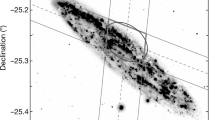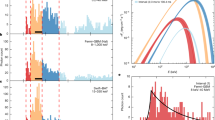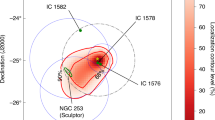Abstract
Magnetar giant flares are rare explosive events releasing up to 1047 erg in gamma rays in less than 1 second from young neutron stars with magnetic fields up to 1015−16 G (refs. 1,2). Only three such flares have been seen from magnetars in our Galaxy3,4 and in the Large Magellanic Cloud5 in roughly 50 years. This small sample can be enlarged by the discovery of extragalactic events, as for a fraction of a second giant flares reach luminosities above 1046 erg s−1, which makes them visible up to a few tens of megaparsecs. However, at these distances they are difficult to distinguish from short gamma-ray bursts (GRBs); much more distant and energetic (1050−53 erg) events, originating in compact binary mergers6. A few short GRBs have been proposed7,8,9,10,11, with different amounts of confidence, as candidate giant magnetar flares in nearby galaxies. Here we report observations of GRB 231115A, positionally coincident with the starburst galaxy M82 (ref. 12). Its spectral properties, along with the length of the burst, the limits on its X-ray and optical counterparts obtained within a few hours, and the lack of a gravitational wave signal, unambiguously qualify this burst as a giant flare from a magnetar in M82.
This is a preview of subscription content, access via your institution
Access options
Access Nature and 54 other Nature Portfolio journals
Get Nature+, our best-value online-access subscription
$29.99 / 30 days
cancel any time
Subscribe to this journal
Receive 51 print issues and online access
$199.00 per year
only $3.90 per issue
Buy this article
- Purchase on Springer Link
- Instant access to full article PDF
Prices may be subject to local taxes which are calculated during checkout



Similar content being viewed by others
Data availability
The data of the INTEGRAL, XMM-Newton and Swift satellites are publicly available in the respective online archives (https://www.isdc.unige.ch/integral/archive, https://www.cosmos.esa.int/web/xmm-newton/xsa, https://swift.gsfc.nasa.gov/archive/). Optical data are available upon request.
Code availability
The software used for the data analysis is public and can be retrieved at https://www.cosmos.esa.int/web/xmm-newton/sas, https://www.isdc.unige.ch/integral/analysis#Software, https://heasarc.gsfc.nasa.gov/xanadu/xspec/.
References
Mereghetti, S. The strongest cosmic magnets: soft gamma-ray repeaters and anomalous X-ray pulsars. Astron. Astrophys. Rev. 15, 225–287 (2008).
Kaspi, V. M. & Beloborodov, A. M. Magnetars. Ann. Rev. Astron. Astrophys. 55, 261–301 (2017).
Hurley, K. et al. A giant periodic flare from the soft γ-ray repeater SGR1900+14. Nature 397, 41–43 (1999).
Palmer, D. M. et al. A giant γ-ray flare from the magnetar SGR 1806-20. Nature 434, 1107–1109 (2005).
Mazets, E. P., Golentskii, S. V., Ilinskii, V. N., Aptekar, R. L. & Guryan, I. A. Observations of a flaring X-ray pulsar in Dorado. Nature 282, 587–589 (1979).
D’Avanzo, P. Short gamma-ray bursts: a review. J. High Energy Astrophys. 7, 73–80 (2015).
Frederiks, D. D. et al. On the possibility of identifying the short hard burst GRB 051103 with a giant flare from a soft gamma repeater in the M81 group of galaxies. Astron. Lett. 33, 19–24 (2007).
Mazets, E. P. et al. A giant flare from a soft gamma repeater in the Andromeda Galaxy (M31). Astrophys. J. 680, 545–549 (2008).
Svinkin, D. et al. A bright γ-ray flare interpreted as a giant magnetar flare in NGC 253. Nature 589, 211–213 (2021).
Burns, E. et al. Identification of a local sample of gamma-ray bursts consistent with a Magnetar Giant Flare origin. Astrophys. J. Lett. 907, L28–L37 (2021).
Trigg, A. C. et al. GRB 180128A: a second Magnetar Giant Flare candidate from the Sculptor Galaxy. Preprint at https://arxiv.org/abs/2311.09362 (2023).
Förster Schreiber, N. M., Genzel, R., Lutz, D. & Sternberg, A. The nature of starburst activity in M82. Astrophys. J. 599, 193–217 (2003).
Mereghetti, S. et al. GRB 231115A: a short hard GRB detected by IBAS, positionally coincident with M82. GRB Coord. Netw. 35037, 1 (2023).
Dalessi, S., Roberts, O. J., Veres, P., Meegan, C. & Fermi Gamma-ray Burst Monitor Team. GRB 231115A: Fermi observations of a probable Magnetar Giant Flare from M82. GRB Coord. Netw. 35044, 1 (2023).
Cheung, C. C. et al. GRB 231115A (short): glowbug gamma-ray detection. GRB Coord. Netw. 35045, 1 (2023).
Xue, W. C., Xiong, S. L., Li, X. B., Li, C. K. & Insight-HXMT Team. GRB 231115A: insight-HXMT/HE detection. GRB Coord. Netw. 35060, 1 (2023).
Frederiks, D. et al. Konus-wind detection of GRB 231115A (a probable Magnetar Giant Flare from M82). GRB Coord. Netw. 35062, 1 (2023).
Wang, Y. et al. Study the origin of GRB 231115A, short gamma-ray burst or magnetar giant flare? Preprint at https://arxiv.org/abs/2312.02848 (2023).
Mereghetti, S., Götz, D., Borkowski, J., Walter, R. & Pedersen, H. The INTEGRAL burst alert system. Astron. Astrophys. 411, L291–L297 (2003).
Ubertini, P. et al. IBIS: the imager on-board INTEGRAL. Astron. Astrophys. 411, L131–L139 (2003).
Burns, E. GRB 231115A: significance of INTEGRAL localization alignment with M82. GRB Coord. Netw. 35038, 1 (2023).
Lebrun, F. et al. ISGRI: the INTEGRAL soft gamma-ray imager. Astron. Astrophys. 411, L141–L148 (2003).
Labanti, C. et al. The IBIS-PICsIT detector onboard INTEGRAL. Astron. Astrophys. 411, L149–L152 (2003).
Freedman, W. L. et al. The Hubble Space Telescope Extragalactic Distance Scale Key Project. I. The discovery of cepheids and a new distance to M81. Astrophys. J. 427, 628–655 (1994).
Osborne, J. P. et al. GRB 231115A: Swift-XRT and Swift-UVOT observations. GRB Coord. Netw. 35064, 1 (2023).
Rigoselli, M., Pacholski, D. P., Mereghetti, S., Salvaterra, R. & Campana, S. GRB 231115A: XMM-Newton observation. GRB Coordinates Network 35175, 1 (2023).
Sakamoto, T. & Gehrels, N. Indication of two classes in the swift short gamma-ray bursts from the XRT X-ray afterglow light curves. In Proc. AIP Conference on Gamma-ray Burst: Sixth Huntsville Symposium Vol. 1133 (eds Meegan, C. et al.) 112–114 (AIP, 2009).
Coti Zelati, F., Rea, N., Pons, J. A., Campana, S. & Esposito, P. Systematic study of magnetar outbursts. Mon. Not. R. Astron. Soc. 474, 961–1017 (2018).
Abbott, B. P. et al. Multi-messenger observations of a binary neutron star merger. Astrophys. J. Lett. 848, L12–L70 (2017).
Ligo Scientific Collaboration, VIRGO Collaboration, and Kagra Collaboration. GRB 231115A: non-detection in low-latency of gravitational waves with LIGO/Virgo/KAGRA. GRB Coord. Netw. 35049, 1 (2023).
Leroy, A. K. et al. A z = 0 Multiwavelength galaxy synthesis. I. A WISE and GALEX atlas of local galaxies. Astrophys. J. Supp. 244, 24–62 (2019).
Duncan, R. C. & Thompson, C. Formation of very strongly magnetized neutron stars: implications for gamma-ray bursts. Astrophys. J. Lett. 392, L9–L13 (1992).
Cehula, J., Thompson, T. A. & Metzger, B. D. Dynamics of baryon ejection in magnetar giant flares: implications for radio afterglows, r-process nucleosynthesis, and fast radio bursts. Mon. Not. R. Astron. Soc. 528, 5323–5345 (2024).
Frederiks, D. D. et al. Giant flare in SGR 1806-20 and its Compton reflection from the Moon. Astron. Lett. 33, 1–18 (2007).
Mereghetti, S. et al. The first giant flare from SGR 1806-20: observations using the anticoincidence shield of the spectrometer on INTEGRAL. Astrophys. J. Lett. 624, L105–L108 (2005).
Goldwurm, A. et al. The INTEGRAL/IBIS scientific data analysis. Astron. Astrophys. 411, L223–L229 (2003).
Arnaud, K. A. XSPEC: the first ten years. In Proc. Astronomical Data Analysis Software and Systems V Vol. 101 (eds Jacoby, G. H. & Barnes, J.) 17–20 (ASP, 1996).
Mereghetti, S., Topinka, M., Rigoselli, M. & Götz, D. INTEGRAL limits on past high-energy activity from FRB 20200120E in M81. Astrophys. J. Lett. 921, L3–L7 (2021).
HI4PI Collaboration. HI4PI: a full-sky H I survey based on EBHIS and GASS. Astron. Astrophys. 594, A116 (2016).
Strüder, L. et al. The European Photon Imaging Camera on XMM-Newton: the pn-CCD camera. Astron. Astrophys. 365, L18–L26 (2001).
Turner, M. J. L. et al. The European Photon Imaging Camera on XMM-Newton: the MOS cameras. Astron. Astrophys. 365, L27–L35 (2001).
Gabriel, C. et al. The XMM-Newton SAS—distributed development and maintenance of a large science analysis system: a critical analysis. In Proc. Astronomical Data Analysis Software and Systems (ADASS) XIII Vol. 314 (eds Ochsenbein, F. et al.) 759–763 (ASP, 2004).
European Space Agency. Dealing with epic out-of-time (OOT) events. XMM-Newton www.cosmos.esa.int/web/xmm-newton/sas-thread-epic-oot (2023).
NASA. Swift GRBS, look up a burst. Goddard Space Flight Center http://swift.gsfc.nasa.gov/archive/grb_table (2023).
Mulgrew, P. Pan-STARRS1 data archive. Space Telescope Science Institute http://outerspace.stsci.edu/display/PANSTARRS/ (2022).
SDSS. SDSS-V: pioneering panoptic spectroscopy www.sdss.org (2022).
Becker, A. HOTPANTS: high order transform of PSF and template subtraction. ascl:1504.004 (Astrophysics Source Code Library, 2015).
Stetson, P. B. DAOPHOT: a computer program for crowded-field stellar photometry. Pub. Ast. Soc. Pac. 99, 191–222 (1987).
Karpov, S. STDPipe: simple transient detection pipeline. ascl:2112.006 (Astrophysics Source Code Library, 2021).
Bradley, L. et al. astropy/photutils: 1.1.0. Zenodo https://doi.org/10.5281/zenodo.4624996 (2021).
astropy, photoutils v.1.11.0. GitHub http://github.com/astropy/photutils (2024).
Rossi, A. et al. A comparison between short GRB afterglows and kilonova AT2017gfo: shedding light on kilonovae properties. Mon. Not. R. Astron. Soc. 493, 3379–3397 (2020).
Bulla, M. POSSIS: predicting spectra, light curves, and polarization for multidimensional models of supernovae and kilonovae. Mon. Not. R. Astron. Soc. 489, 5037–5045 (2019).
Ferro, M. et al. A search for the afterglows, kilonovae, and host galaxies of two short GRBs: GRB 211106A and GRB 211227A. Astron. Astrophys. 678, A142–A162 (2023).
Acknowledgements
We thank the ESA Mission Scientists J.-U. Ness and N. Schartel for approving and quickly implementing the INTEGRAL and XMM-Newton ToO observations. This work is based on observations with INTEGRAL and XMM-Newton, ESA missions with instruments and science data centres funded by ESA member states, and with the participation of the Russian Federation and the United States. It is also based on observations made with the Italian TNG operated on the island of La Palma by the Fundación Galileo Galilei of the INAF (Istituto Nazionale di Astrofisica) at the Spanish Observatorio del Roque de los Muchachos of the Instituto de Astrofisica de Canarias. This paper includes optical data taken with the Schmidt 67/92 telescope operated by INAF Osservatorio Astronomico di Padova (Mount Ekar, Asiago). This work received financial support from INAF through the Magnetars Large Program Grant (Principal Investigator S.M.) and from the GRAWITA Large Program Grant (Principal Investigator P.D.A.). J.C.R., A.B., S.M. and P.U. acknowledge financial support from ASI under contract no. 2019-35-HH.0. F.O. acknowledges support from MIUR, PRIN 2020 (grant no. 2020KB33TP) ‘Multimessenger astronomy in the Einstein Telescope Era’ (METE). J.C.R. acknowledges support from the European Union’s Horizon 2020 Programme under the AHEAD2020 project (grant agreement no. 871158). P.D.A. and S.C. acknowledge funding from the Italian Space Agency, contract ASI/INAF no. I/004/11/4.
Author information
Authors and Affiliations
Contributions
All authors reviewed the manuscript and contributed to the source interpretation. S.M. coordinated the work and the interpretation of the results, contributed to the analysis of the INTEGRAL and XMM-Newton data, and wrote most of the manuscript. R.S. and E.A. contributed to write the main part of the paper. D.P.P. and J.C.R. carried out most of the INTEGRAL data analysis. D.G., C.F., E.B., L.D. and V.S. routinely contribute to the operation of the IBAS software and participated to the near real time INTEGRAL analysis. P.D.A. coordinated the analysis of the optical data from Italian telescopes. M.R. analysed the XMM-Newton data and contributed to the INTEGRAL spectral analysis. S.C. analysed the Swift data. M.T. contributed to the software for the burst search in archival data. D.T., W.T., D.S. and C.A. coordinated the observation and the analysis of the optical data taken at OHP. L.T. analysed the optical data taken with the Schmidt 67/92 telescope in Asiago under the Large Program ‘Search and characterization of optical counterparts of GW triggers’ (P.I. Tomasella). A.R. and E.C. triggered, reduced and analysed the observations at the Asiago Schmidt telescope. R.B. and M.F. provided the short GRB afterglows and kilonovae observed and simulated optical light curves.
Corresponding author
Ethics declarations
Competing interests
The authors declare no competing interests.
Peer review
Peer review information
Nature thanks Eric Burns and David Palmer for their contribution to the peer review of this work.
Additional information
Publisher’s note Springer Nature remains neutral with regard to jurisdictional claims in published maps and institutional affiliations.
Extended data figures and tables
Extended Data Fig. 1 EPIC-pn images of M82.
The exposure-corrected images refer to the 0.3−2 keV (a) and 2−10 keV (b) energy ranges. The 90% c.l. error circle of GRB 231115A has a radius of 2 arcmin.
Extended Data Fig. 2 Maps of count rate upper limits.
The figure gives 3-σ upper limits on the 2−10 keV count rates of the EPIC-MOS1 (a), EPIC-MOS2 (b) and EPIC-pn (c) cameras. The 90% c.l. error circle of GRB 231115A has a radius of 2 arcmin.
Extended Data Fig. 3 Maps of flux upper limits.
The figure gives 3-σ upper limits on the fluxes in the 2−10 keV (a) and 0.3−10 keV (b) energy range, obtained by combining the three maps of Extended Data Fig. 2. The 90% c.l. error circle of GRB 231115A has a radius of 2 arcmin.
Extended Data Fig. 4 X-ray light curves of short GRB afterglows.
The Swift/XRT (black square) and XMM-Newton/EPIC (black diamond) 3-σ upper limits of GRB 231115A are indicated.
Extended Data Fig. 5 Optical light curves of kilonovae.
The r-band light curves of AT2017gro and of the faintest red kilonova (simulated with the POSSIS code) are shown with dashed and solid lines, respectively, assuming the M82 distance (3.6 Mpc). The magnitude 3-σ upper limits obtained for a position inside (outside) the M82 galaxy are shown as blue (red) arrows.
Extended Data Fig. 6 Optical light curves of short GRB afterglows.
The observed light curves are shown in a, while b shows the light curves of those GRBs which have a measure of redshift, rescaled to the M82 distance (3.6 Mpc). The 3-σ upper limits obtained for a position inside (outside) the M82 galaxy are shown as blue (red) arrows.
Rights and permissions
Springer Nature or its licensor (e.g. a society or other partner) holds exclusive rights to this article under a publishing agreement with the author(s) or other rightsholder(s); author self-archiving of the accepted manuscript version of this article is solely governed by the terms of such publishing agreement and applicable law.
About this article
Cite this article
Mereghetti, S., Rigoselli, M., Salvaterra, R. et al. A magnetar giant flare in the nearby starburst galaxy M82. Nature 629, 58–61 (2024). https://doi.org/10.1038/s41586-024-07285-4
Received:
Accepted:
Published:
Issue Date:
DOI: https://doi.org/10.1038/s41586-024-07285-4
Comments
By submitting a comment you agree to abide by our Terms and Community Guidelines. If you find something abusive or that does not comply with our terms or guidelines please flag it as inappropriate.



